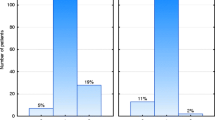Abstract
Objectives
To evaluate the impact of patient and treatment factors on the incidence and timing of moist desquamation (MD) during adjuvant whole-breast radiotherapy (RT).
Methods
Sixty-nine consecutive patients treated with lumpectomy and tangential-field whole-breast RT to 46-50 Gy in 2 Gy fractions were reviewed. Separate contours were generated for the skin and irradiated breast. Patient factors and dosimetric data for breast and skin contours were assessed using univariate and multivariate logistic regressions to determine the significant predictors of moist desquamation during RT. Kaplan–Meier analyses and log-rank tests assessed the influence of these factors on time-to-development of MD.
Results
Twenty-three patients (33.3 %) developed MD at a median of 46 Gy. MD occurred earlier for patients with a BMI >30, >45 cm3 of skin receiving 45 Gy or >15 cm3 receiving 50 Gy, and >1,300 cm3 breast receiving 50 Gy. In multivariate logistic regressions, only BMI remained as a statistically significant predictor of MD, as BMI was correlated with higher volumes of breast and skin receiving at least 50 Gy.
Conclusions
In tangential field breast RT, dose–volume relationships influence the development and timing of MD. Fine differences in dose delivered to skin and subcutaneous structures appear to significantly alter the time course of MD development.





Similar content being viewed by others
References
Clarke M, Collins R, Darby S et al (2005) Effects of radiotherapy and of differences in extent of surgery for early breast cancer on local recurrence and 15-year survival: an overview of the randomized trials. Lancet 366:2087–2106
Fisher J, Scott C, Stevens R et al (2000) Randomized phase III study comparing best supportive care to Biafine as a prophylactic agent for radiation-induced skin toxicity for women undergoing breast irradiation: Radiation Therapy Oncology Group (RTOG) 97–13. Int J Radiat Oncol Biol Phys 48:1307–1310
Tieu MT, Graham P, Browne L, Chin YS (2011) The effect of adjuvant postmastectomy radiotherapy bolus technique on local recurrence. Int J Radiat Oncol Biol Phys 81(3):e165–e171
Pignol JP, Olivoto I, Rakovitch E et al (2008) A multicenter randomized trial of breast intensity-modulated radiation therapy to reduce acute radiation dermatitis. J Clin Oncol 26(13):2085–2092
Bentzen SM, Overgaard M (1991) Relationship between early and late normal tissue injury after postmastectomy radiotherapy. Radiother Oncol 20:159–165
Fernando IN, Ford HT, Powles TJ et al (1996) Factors affecting acute skin toxicity in patients having breast irradiation after conservative surgery: A prospective study of treatment practice at the Royal Marsden Hospital. Clin Oncol 8:226–233
Twardella D, Popanda O, Helmbold I et al (2003) Personal characteristics, therapy modalities, and individual DNA repair capacity as predictive factors of acute skin toxicity in an unselected cohort of breast cancer patients receiving radiotherapy. Radiother Oncol 69:145–153
Back M, Guerrieri M, Wratten C, Steigler A (2004) Impact of radiation therapy on acute toxicity in breast conservation therapy for early breast cancer. Clin Oncol 16:12–16
Chen MF, Chen WC, Lai CH et al (2010) Predictive factors of radiation-induced skin toxicity in breast cancer patients. BMC Cancer 10:508–516
Freedman GM, Anderson PR, Li J et al (2006) Intensity modulated radiation therapy (IMRT) decreases acute skin toxicity for women receiving radiation for breast cancer. Am J ClinOncol 29(1):66–70
Kim JH, Hill R, Kuncic Z (2012) Practical considerations for reporting surface dose in external beam radiotherapy: a 6 MV X-ray beam study. Australas Phys Eng Sci Med 35(3):271–282
Conflict of interest
Charles Rutter, Li Qin, Susan Higgins, Meena Moran, and Suzanne Evans report that they have no conflicts of interest to disclose. This article does not contain any studies with human or animal subjects performed by any of the authors.
Author information
Authors and Affiliations
Corresponding author
Rights and permissions
About this article
Cite this article
Rutter, C.E., Qin, L., Higgins, S.A. et al. Dosimetric and clinical predictors of the development of moist desquamation in breast cancer irradiation. J Radiat Oncol 3, 147–152 (2014). https://doi.org/10.1007/s13566-013-0129-0
Received:
Accepted:
Published:
Issue Date:
DOI: https://doi.org/10.1007/s13566-013-0129-0




